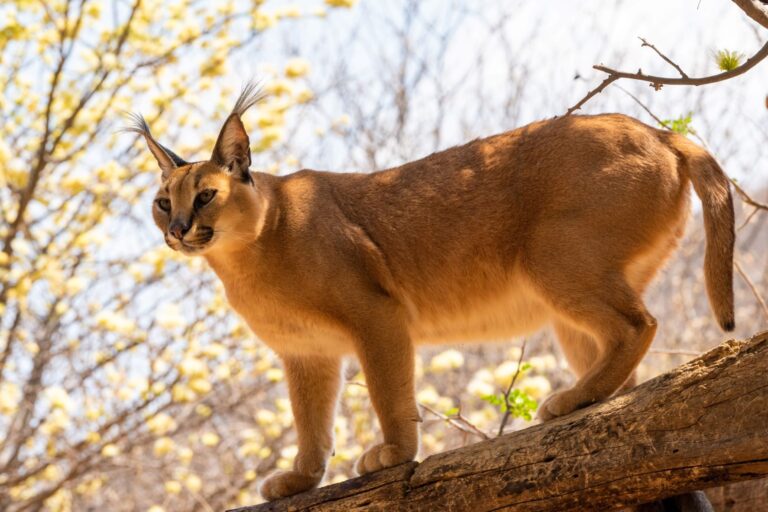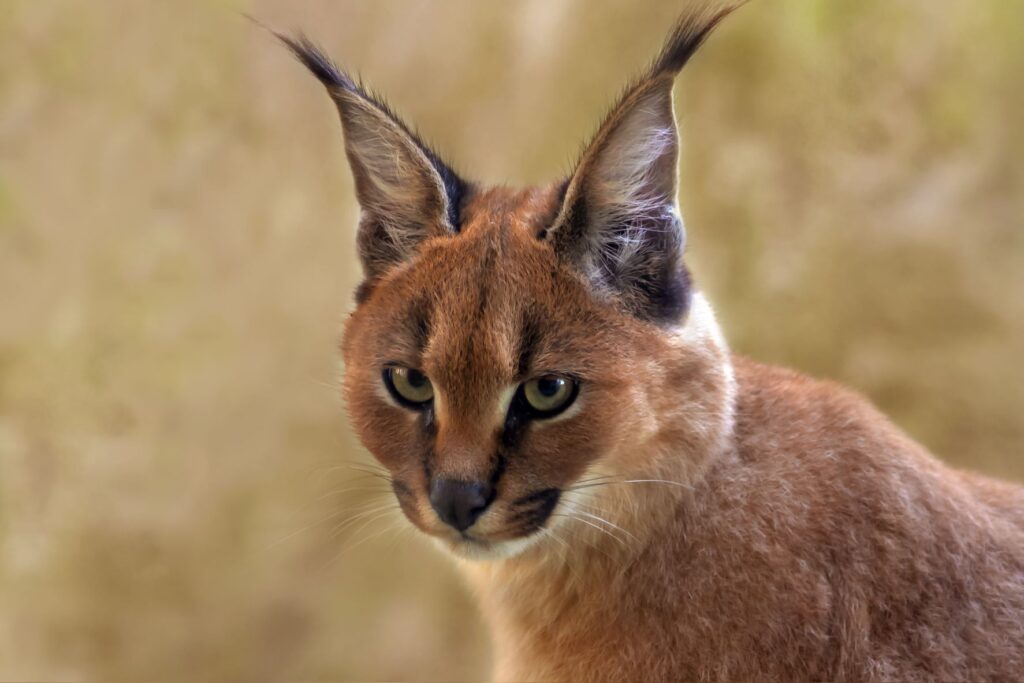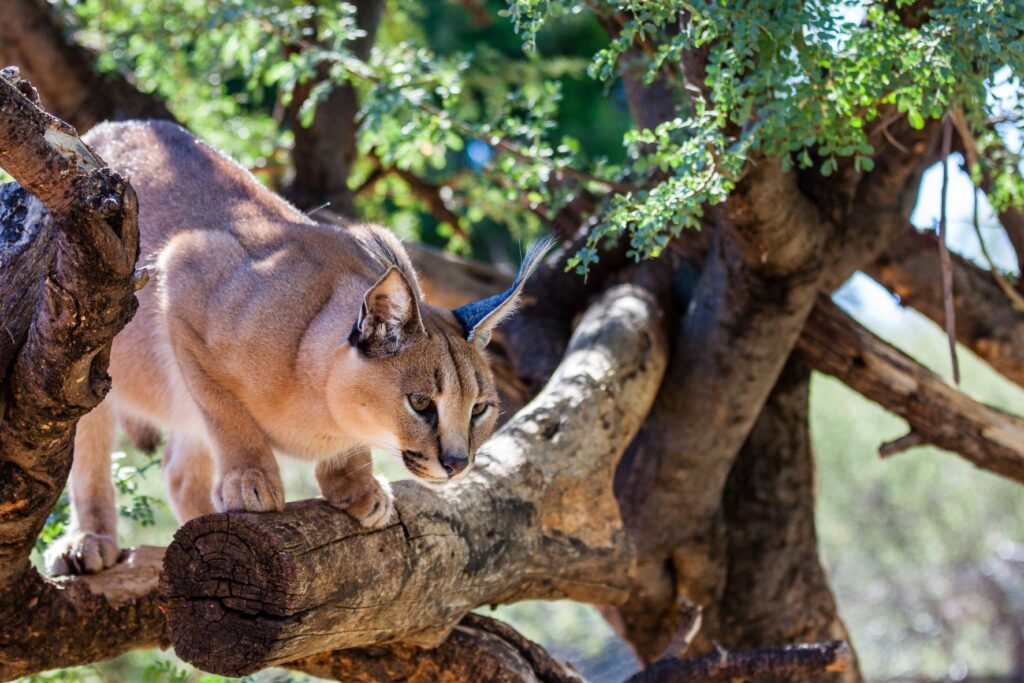Maine Coon
The Maine Coon has become one of the most popular cat breeds in the world. This is probably due to its majestic appearance, robust nature and great character.
The caracal is native to the arid regions of Asia and Africa. With its black ear tufts, it is similar in appearance to the lynx, leading to its nickname: the desert lynx. Some people keep a caracal as an exotic pet. However, caracals are wild animals and should not be in private ownership.

© Manok / stock.adobe.com
The face of the caracal features a black and white marking.
The caracal belongs to the cat family. The predatory cat owes its name to the distinctive black-tufted hairs at the tips of its ears: “Karakulak” means “black ear” in Turkish. The backsides of the ears are also black.
The fur colour depends on the caracal’s habitat. The range varies from sandy or ochre in drier regions to a brick-red hue in areas with more precipitation. The belly is always slightly lighter and has a subtle spotted pattern.
The face of the caracal features a black and white marking.
With an average body length of 65 centimetres and a shoulder height of 45 centimetres, caracals are medium-sized cats. They can reach up to one metre in length. The tail is around 30 centimetres long.
A male weighs between 13 and 18 kilograms, while females are slightly smaller and lighter.
Like the lynx, the caracal’s hind legs are longer than its front legs. This allows the animals to jump up to three meters high from a standing start! Thanks to their impressive jumping ability, caracals can even catch birds in flight.
For a long time, it was believed that the caracal (scientific name: Caracal caracal) and the lynx (Lynx) were closely related. Both species belong to the cat family (Felidae), have tufts on their ears, and similar stature and size. The caracal is often referred to as the desert lynx due to its likeness to the lynx.
However, there are differences: the ear tufts on the caracal are longer than those on the lynx. Unlike the lynx, the caracal does not have whiskers on the sides of its face or a bobbed tail.
Recent genetic studies have shown that the closest relative to the caracal is the African golden cat (Caracal aurata).
 © farbkombinat / stock.adobe.com
© farbkombinat / stock.adobe.com
Caracals live in semi-deserts, steppes, and dry savannahs.
Their range extends from the Arabian Peninsula to Asia. Countries where caracals are found include Israel, Turkey, Jordan, Syria, Kuwait, Iraq, Iran, Pakistan, Turkmenistan, and India. Additionally, the desert lynxes call the regions of North, Central, and South Africa home.
The animals are not on the IUCN Red List of Threatened Species. However, in some parts of Asia, they are now rarely encountered, as their habitats continue to shrink. Larger populations are found primarily in South Africa’s Cape Province.
Outside of mating season, these predatory cats live solitary lives. They have their territories, which vary greatly in size: from five square kilometres to 200 square kilometres.
Their ranges can overlap. To avoid unwanted encounters with conspecifics, the animals leave urine and scent marks. These scent signals, imperceptible to humans, also carry messages, such as about the health of males or the mating readiness of females.
Like all cats, caracals communicate not only through scent signals but also through cat sounds. Their vocalisations include meowing, hissing, and purring.
Females typically give birth to one to three kittens per litter. The mating season varies with the climate. Caracal females always give birth during the time of year when prey is most abundant, to ensure the mother can easily procure food for her offspring.
The gestation period lasts about 80 days. At birth, the female retreats to a safe place, such as a cave in the rocks.
Caracal kittens are born blind and utterly helpless, weighing just about 250 grams at birth. They open their eyes for the first time when they are around ten days old.
At the age of one month, they get their milk teeth. Now they can eat the solid food their mother has caught for them.
They start their first hunting attempts when they are approximately six to seven months old. At the beginning, the young predators are clumsy, but they become more skillful hunters over time.
When they are about a year old, the young leave their mother to find their hunting territory. Caracals are fully grown by two years of age.
In captivity, caracals can live up to 16 years.
Like all cats, the caracal is an obligate carnivore and occasionally eats a small amount of grass. They rarely drink water, as they get most of their hydration from food.
Their preferred hunting time is at night. The cat stealthily approaches its prey and then surprises it with a rapid attack.
The cat’s diet includes rodents, birds, antelopes, hares, and hyraxes (mammals similar to marmots). It kills its prey with a powerful bite to the neck or throat.
Domestic animals, such as goats, are also on the caracal’s menu. Consequently, in South Africa’s Cape Province, people hunt them.
 © mophoto / stock.adobe.com
© mophoto / stock.adobe.com
Well into the 20th century, tame caracals were kept in India and Iran for hunting hares and small game.
Today, these predatory cats have become exotic pets and status symbols.
Even if you are fascinated by the beauty of these animals and the high price is not an issue – a caracal as a house cat is not a good idea. Caracals are wild animals and are not suited for a life in captivity. Suitable care in a private household is therefore impossible. Even the largest enclosure does not compare to a caracal’s territory, and the animals cannot satisfy their hunting instinct in human care.
Please note that while house cats are perfectly legal to own in the UK, larger members of the Felidae family require a license.
Moreover, caracals can become very dangerous. With their sharp teeth and claws, they can inflict severe injuries on humans. Time and again, unplanned predatory cat acquisitions end up in rescue centres or animal shelters because their owners were overwhelmed and became fearful of them.
In many federal states, private ownership of predatory cats and predatory cat hybrids is either banned or subject to strict regulations.
In response to growing demand for exotic predatory cats in a more manageable size, more hybrid breeds have emerged. Among the most well-known wild cat hybrids are the Bengal cat and the Savannah.
The so-called Caracat results from crossing a domestic cat with a caracal. Its breeding is particularly problematic: a domestic cat can suffer severe injuries when mating with a caracal male, which is much larger and stronger.
The differing gestation periods of domestic cats (63 days) and caracals (80 days) can also lead to health issues and developmental problems in the kittens.
Another risk is the wild nature of the predatory cat hybrids, which can be quite dangerous for their owners.
For ethical reasons, you should neither buy a caracal nor a Caracat. Instead, consider a “regular” indoor cat or a pedigree cat from an animal shelter.
After all, the Italian artist Leonardo Da Vinci already knew: “Even the smallest cat is a masterpiece.”
| Characteristics: | The caracal is a predatory cat that resembles a lynx with its black ear tufts. Although so-called desert lynxes can can be found in human care, they truly belong in the wild. |
| Character: | Solitary, territorial, active |
| Size: | 60 – 100 cm (male generally larger), 45 cm at the shoulder (male and female) |
| Weight: | 13 – 18 kg (male), 8 – 16 kg (female) |
| Eye Colour: | Yellow-brown |
| Colours: | Depends on habitat, ranging from sand-coloured or ochre to brick-red |
| Fur: | Short-haired |
| Coat Care: | Easy to care for (usually no coat care required) |
| Life Expectancy: | 16 to 19 years |
| Typical Diseases: | Tendency to obesity in private hands |
| Price: | €6500 to €9000 (purchase regulations may apply in many countries) |
| Origin: | Asia and Africa (jungles, savannahs, woodland areas, deserts) |
The Maine Coon has become one of the most popular cat breeds in the world. This is probably due to its majestic appearance, robust nature and great character.
Large eyes and attentively upright ears instantly tell you a great deal about this charming breed of cat: Abyssinians are inquisitive and affectionate towards people.
With its long, dense fur, rounded ears, and intense stare, the Pallas Cat, or Manul, looks rather fluffy, yet somewhat dangerous. However, don't be fooled by its appearance—this is no petting zoo resident. The Manul is a wild animal and considered untameable.